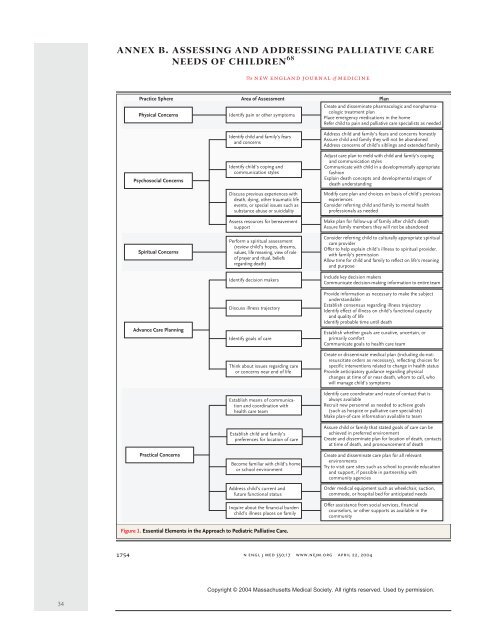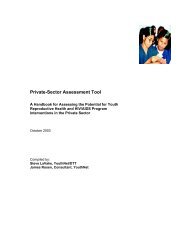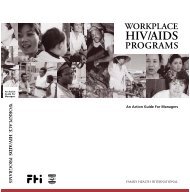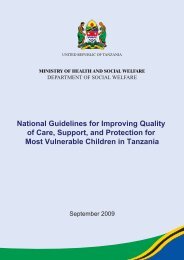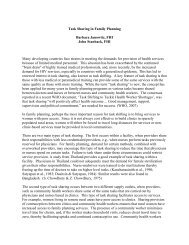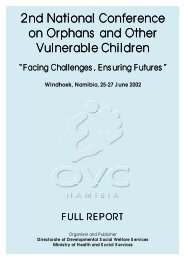Palliative Care Strategy for HIV and other diseases - FHI 360
Palliative Care Strategy for HIV and other diseases - FHI 360
Palliative Care Strategy for HIV and other diseases - FHI 360
You also want an ePaper? Increase the reach of your titles
YUMPU automatically turns print PDFs into web optimized ePapers that Google loves.
34<br />
annex b. assessing <strong>and</strong> addressing palliative care<br />
needs of children 68<br />
1754<br />
Practice Sphere Area of Assessment<br />
Physical Concerns<br />
Psychosocial Concerns<br />
Spiritual Concerns<br />
Advance <strong>Care</strong> Planning<br />
Practical Concerns<br />
Figure 1. Essential Elements in the Approach to Pediatric <strong>Palliative</strong> <strong>Care</strong>.<br />
The new engl<strong>and</strong> journal of medicine<br />
Identify pain or <strong>other</strong> symptoms<br />
Identify child <strong>and</strong> family’s fears<br />
<strong>and</strong> concerns<br />
Identify child’s coping <strong>and</strong><br />
communication styles<br />
Discuss previous experiences with<br />
death, dying, <strong>other</strong> traumatic life<br />
events, or special issues such as<br />
substance abuse or suicidality<br />
Assess resources <strong>for</strong> bereavement<br />
support<br />
Per<strong>for</strong>m a spiritual assessment<br />
(review child’s hopes, dreams,<br />
values, life meaning, view of role<br />
of prayer <strong>and</strong> ritual, beliefs<br />
regarding death)<br />
Identify decision makers<br />
Discuss illness trajectory<br />
Identify goals of care<br />
Think about issues regarding care<br />
or concerns near end of life<br />
Establish means of communication<br />
<strong>and</strong> coordination with<br />
health care team<br />
Establish child <strong>and</strong> family’s<br />
preferences <strong>for</strong> location of care<br />
Become familiar with child’s home<br />
or school environment<br />
Address child’s current <strong>and</strong><br />
future functional status<br />
Inquire about the financial burden<br />
child’s illness places on family<br />
n engl j med 350;17<br />
Create <strong>and</strong> disseminate pharmacologic <strong>and</strong> nonpharmacologic<br />
treatment plan<br />
Place emergency medications in the home<br />
Refer child to pain <strong>and</strong> palliative care specialists as needed<br />
Address child <strong>and</strong> family’s fears <strong>and</strong> concerns honestly<br />
Assure child <strong>and</strong> family they will not be ab<strong>and</strong>oned<br />
Address concerns of child’s siblings <strong>and</strong> extended family<br />
Adjust care plan to meld with child <strong>and</strong> family’s coping<br />
<strong>and</strong> communication styles<br />
Communicate with child in a developmentally appropriate<br />
fashion<br />
Explain death concepts <strong>and</strong> developmental stages of<br />
death underst<strong>and</strong>ing<br />
Modify care plan <strong>and</strong> choices on basis of child’s previous<br />
experiences<br />
Consider referring child <strong>and</strong> family to mental health<br />
professionals as needed<br />
Make plan <strong>for</strong> follow-up of family after child’s death<br />
Assure family members they will not be ab<strong>and</strong>oned<br />
Consider referring child to culturally appropriate spiritual<br />
care provider<br />
Offer to help explain child’s illness to spiritual provider,<br />
with family’s permission<br />
Allow time <strong>for</strong> child <strong>and</strong> family to reflect on life’s meaning<br />
<strong>and</strong> purpose<br />
Include key decision makers<br />
Communicate decision-making in<strong>for</strong>mation to entire team<br />
Provide in<strong>for</strong>mation as necessary to make the subject<br />
underst<strong>and</strong>able<br />
Establish consensus regarding illness trajectory<br />
Identify effect of illness on child’s functional capacity<br />
<strong>and</strong> quality of life<br />
Identify probable time until death<br />
Establish whether goals are curative, uncertain, or<br />
primarily com<strong>for</strong>t<br />
Communicate goals to health care team<br />
Create or disseminate medical plan (including do-notresuscitate<br />
orders as necessary), reflecting choices <strong>for</strong><br />
specific interventions related to change in health status<br />
Provide anticipatory guidance regarding physical<br />
changes at time of or near death, whom to call, who<br />
will manage child’s symptoms<br />
Identify care coordinator <strong>and</strong> route of contact that is<br />
always available<br />
Recruit new personnel as needed to achieve goals<br />
(such as hospice or palliative care specialists)<br />
Make plan-of-care in<strong>for</strong>mation available to team<br />
Assure child or family that stated goals of care can be<br />
achieved in preferred environment<br />
Create <strong>and</strong> disseminate plan <strong>for</strong> location of death, contacts<br />
at time of death, <strong>and</strong> pronouncement of death<br />
Create <strong>and</strong> disseminate care plan <strong>for</strong> all relevant<br />
environments<br />
Try to visit care sites such as school to provide education<br />
<strong>and</strong> support, if possible in partnership with<br />
community agencies<br />
Order medical equipment such as wheelchair, suction,<br />
commode, or hospital bed <strong>for</strong> anticipated needs<br />
Offer assistance from social services, financial<br />
counselors, or <strong>other</strong> supports as available in the<br />
community<br />
www.nejm.org april 22,<br />
2004<br />
Copyright © 2004 Massachusetts Medical Society. All rights reserved. Used by permission.<br />
Plan


